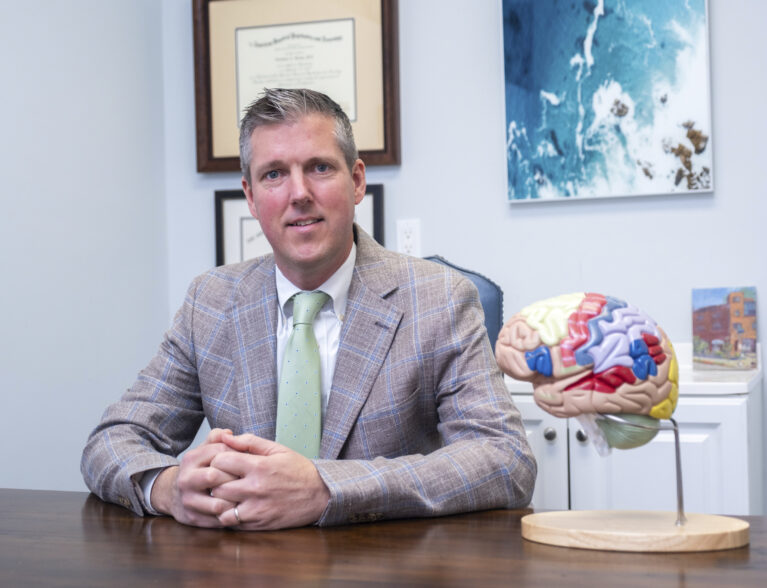
Benzodiazepines were developed in the 1950s and introduced into general use in the 1960s, but some people are learning about them for the first time as they’ve been in the spotlight on this season of the popular HBO series “The White Lotus,” where characters Tim and Victoria Ratliff down them with abandon.
Benzodiazepines (benzos) are a class of medications that slow down activity in your brain and nervous system. Although the drug featured on “The White Lotus” is lorazepam (Ativan), you may also recognize the names Xanax and Valium, two other widely prescribed brands in the U.S.
Dr. Jonathan A. Beatty, an addiction psychiatrist with a practice in Vero Beach, says that benzos are meant to be taken occasionally, and when used in that way, they are effective.
“Used appropriately – for instance if you’re a nervous flyer and this gets you through the flight – they do a good job. People need to think of using it on an ‘as needed’ basis only.”
Benzos are primarily used to treat anxiety, stress, insomnia, epilepsy and to sedate people before certain medical procedures.
“The problem begins when people start to like the feeling they get and want to take more and more,” he adds.
Good as they may feel, the drugs can be dangerous and detrimental to wellbeing.
Dr. Beatty says that it’s easy for people to take benzos without completely understanding how they may become addicted or what their interactions are. When benzodiazepines are combined with other sedatives, opiates or alcohol, the risk of serious side effects such as profound sedation, respiratory depression, coma and death may occur.
Dr. Gail Saltz, a clinical associate professor of psychiatry at New York-Presbyterian Weill Cornell Medical Center, shared her expertise with CNN. She explained that alcohol combines effects with benzodiazepine. They both can cause, on their own, respiratory depression and death – meaning you stop breathing and die.
Together, they are what’s called synergistic, meaning each of them have more effect when combined than they do when used separately. Hence the frequent warning not to drink when you’re taking lorazepam.
The way Tim Ratliff was downing lorazepam and drinking to excess on “The White Lotus,” it wouldn’t have been a plot twist if he didn’t wake up in the morning.
There are controlled and non-controlled medications. Dr. Beatty explains the difference. “Most prescriptions for infections or for chronic conditions are non-controlled. For example, most blood pressure and cholesterol medications are non-controlled medications. Same with diabetes medications (including insulin), asthma inhalers and antibiotics.
“Controlled substances are medications that can cause physical and mental dependence. There are restrictions on how they can be prescribed and refilled. Controlled substances are regulated and classified by the Drug Enforcement Administration. Regulations are based on how likely they are to be abused and cause dependence,” Dr. Beatty says.
Within the controlled substance category are schedules, based on whether a specific drug has a currently accepted medical use in the United States, the relative abuse potential, and the likelihood of causing dependence when abused. Schedule 1 drugs have no medical value and high potential for abuse, while schedule 2-5 substances all have some medical value but differ in ranking depending on their potential for abuse.
“Benzos fall into category 4,” says Dr. Beatty, “but I think with its abuse potential it should be on a lower schedule. Maybe then prescribers would be more cautious in giving it to patients.”
The Ohio Hospital for Psychiatry lists a wide array of benzo addiction signs and symptoms on its website. Among them are:
Behavioral symptoms:
- Drug-seeking behaviors.
- Doctor shopping, or visiting several doctors to obtain more prescriptions.
- Forging prescriptions.
- Increasing desire to be left alone.
Physical symptoms: - Increased respiratory infections.
- Physical dependence
- Double vision.
- Muscle weakness.
Cognitive symptoms: - Memory impairment.
- Increased confusion.
- Slowed reaction time.
Dr. Beatty explains that withdrawal from high dosage needs to be gradual. “You may experience shakiness, high blood pressure, seizures and DTs. You definitely want to undertake this with the help of a professional.
“You don’t know if you’ll become addicted to benzos until you try them. If you’re starting to feel like you need more, talk to a doctor or medical professional. Your tolerance can change – what started out to be an effective dose may become an ineffective one over time.
“There are ways we can help you through the journey of withdrawal.”
Dr. Jonathan A. Beatty, M.D., is triple board-certified in Psychiatry and Neurology, Pain Medicine and Addiction Medicine. After an internship and residency at Louisiana State University, he honed his skills in psychiatry at Hahnemann and Drexel University in Pennsylvania, where he also took specialized training in neurology and pain medicine. His practice, Wave Treatments, is located at 777 37th St., Suite C103, Vero Beach 32960. Call 772-300-9077 for an appointment.



